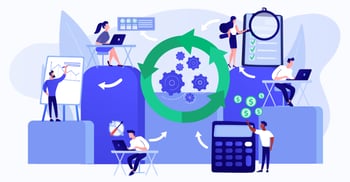15 Payment Revolution Innovations for SaaS & Software

To maximize success, align your payment methods with user expectations:
It will be necessary to become proficient in new tools, technologies, and customer expectations by 2025 in order to keep ahead of the quickly evolving payment landscape. These technologies, whether they are used to manage video game payments , develop SaaS platforms, or introduce software products globally, are revolutionizing the way people pay.
This guide concentrates on the key trends for SaaS payments and technologies that support worldwide expansion, enhanced user experience, and higher conversion rates for digital SaaS companies.
What Is the 2025 Payment Revolution?
The 2025 payment revolution is a technological trend toward faster, more secure, and intelligent transactions. AI, machine intelligence, open banking, and embedded finance are transforming how customers pay—and digital businesses function.
15 Payment Innovations To Remember
1. Open Banking Powers Personalized, Fast Payments
Open banking allows secure data sharing between banks and third-party providers via payment APIs.
In 2025, open banking users are projected to exceed 200 million globally.
Supports personalized offers, real-time account verification, and seamless bank payments.
Key for EU, UK, and expanding markets driven by PSD2 and global equivalents.
2. Embedded Payments Eliminate Checkout Friction
Customers now expect to pay without ever leaving your platform.
Embedded SaaS payments are fully integrated into apps, websites, and games—no redirection required.
Boosts conversion by up to 25%.
Did you know?
PayPro Global enables embedded payment orchestration across 70+ methods.
3. Localized Carts in Local Languages Win More Sales
Localization is a revenue driver—not just a nice-to-have.
Offering checkout in a user’s native language can increase conversions by 40–70%.
Did you know?
PayPro Global supports 30+ cart languages and 140+ currencies, making cross-border sales seamless
4. In-App and In-Game Payments Fuel the Creator Economy
By 2026, global in-app purchases are projected to exceed $233 billion.
Games, mobile SaaS apps, and creative tools are now monetized directly inside the experience.
One-tap payments and biometric approvals drive high repeat purchases and lower drop-off rates.
Example
Game developers can monetize skins, power-ups, and season passes without leaving the app.
5. One-Click Payments Boost Repeat Transactions
Stored credentials and secure tokenization let users pay instantly.
Increases conversion rates by 30–50% for recurring billing.
Essential for subscription billing for SaaS platforms and premium software trials.
6. AI-Powered Payment Routing Maximizes Approval Rates & Revenue Recovery
AI analyzes each transaction in real time to find the best processing route.
Reduces failed transactions by up to 12%.
Smart cascading logic considers card type, user location, fraud risk, and more.
Did you know?
PayPro Global’s orchestration engine uses adaptive learning to optimize routes dynamically.
7. Instant Payments Improve User Satisfaction and Cash Flow
Real-time payments are now live in 70+ countries.
Funds settle within seconds, 24/7/365.
Crucial for SaaS and game platforms where instant access = instant satisfaction.
eCommerce Partner
Thrive with the industry's most innovative all-in-one SaaS & Digital Goods solution. From high-performing payment and analytics tools to complete tax management, as well as subscription & billing handling, PayPro Global is ready to scale your SaaS.
Sell your SaaS globally with PayPro Global!
8. Machine Learning Fraud Prevention Minimizes False Declines
AI identifies unusual behavior patterns to stop fraud in real time.
Reduces false positives that lead to cart abandonment (42% of customers never retry after a decline).
Learns from billions of transactions—no manual rules required.
Did you know?
PayPro Global’s fraud engine saved clients over millions in lost revenue.
9. Biometric Authentication Offers Secure, Seamless Access
Biometrics are now mainstream—and preferred by users.
62% of users would switch providers for biometric payment options.
Facial recognition, fingerprint scanning, and voice ID speed up transactions without compromising security.
10. Simplify Multi-Currency Management
Operate globally without needing local bank accounts in every region.
Centralize funds across currencies.
Easier reconciliation, FX transparency, and reduced fees.
Great for software monetization into LATAM, APAC, and the Middle East.
11. Smart Cross-Border Payments Remove Global Barriers
Cross-border digital payments are expected to hit $42 trillion in 2025.
APIs now handle everything from local tax compliance to FX optimization.
Did you know?
With PayPro Global, you can accept local payments globally, reduce chargebacks, and support regional settlement rules.
12. Frictionless Authorization Improves Conversion at Checkout
New tech removes outdated steps like forms and document uploads.
Tools like 3DS 2.2, device fingerprinting, and geolocation replace clunky verifications.
PSD2 compliance with minimal user input.
Greatly reduces cart abandonment in Europe and beyond.
13. Data-Driven Insights Simplify Payment Optimization
Real-time analytics help businesses identify friction, fraud, and revenue leaks.
Track gateway performance, failed transaction patterns, and regional behaviors.
Use data to increase ROI, improve UX, and drive smarter decisions.
Did you know?
PayPro Global provides customizable dashboards for actionable payment insights.
14. Specialized Payment Tools for Gaming Monetization
The gaming economy has unique needs: microtransactions, regional currency bundles, fraud risks.
PayPro Global supports:
- In-game currencies & IAPs
- Bundle pricing per region
- Anti-fraud for high-volume digital goods
Helps developers prevent abuse of refund policies, payment reversals, and fraudulent chargebacks.
15. Democratization of Payments Supports Global Inclusion
Despite progress, over 1.4 billion people still lack access to traditional banking.
Payment providers are now building mobile-first, low-bandwidth solutions.
Central bank digital currencies (CBDCs) and mobile wallets are expanding in Africa, India, and Southeast Asia.
The future? Seamless payments for all customers, no matter their tech level.
How to Choose the Right Payment Methods by Region
To maximize success, align your payment methods with user expectations:
|
Region |
Preferred Payment Methods |
|
North America |
Credit/debit cards, PayPal, Apple Pay |
|
Europe |
SEPA, SOFORT, iDEAL, Buy Now Pay Later (BNPL) |
|
LATAM |
Boleto, PIX, local cards |
|
APAC |
Alipay, WeChat Pay, JCB, UPI |
|
Africa |
Mobile money, card wallets, Flutterwave |
eCommerce Partner
Thrive with the industry's most innovative all-in-one SaaS & Digital Goods solution. From high-performing payment and analytics tools to complete tax management, as well as subscription & billing handling, PayPro Global is ready to scale your SaaS.
Sell your SaaS globally with PayPro Global!
How PayPro Global’s Merchant of Record Helps You Scale Smoothly
PayPro Global is the trusted payment Merchant of Record partner for SaaS and gaming businesses looking to grow globally.
- Supports 70+ payment methods, 140+ currencies, and 30+ languages
- Smart fraud prevention + AI-powered routing = up to 30% more approved transactions
- Real-time dashboards and analytics to manage performance
- Built-in support for disputes, chargebacks, and regional compliance
Our solution equips businesses with flawless payment processing services, smart routing to recover lost payments, in-app and in-shopper account purchases, and many more features to ensure that your customer has a rewarding journey.
Choose our all-in-one Merchant of Record platform to expand your SaaS sales worldwide and maintain its success.
Conclusion
The 2025 payment revolution is about providing your people with the fastest, safest, and most enjoyable experience imaginable. Payments are now an important component of any product strategy, whether you're developing the next major SaaS platform, a fast-paced game, or selling software abroad.
Book a call with PayPro Global and discover how our all-in-one payment orchestration platform can take your growth global.
FAQs
How does PayPro Global handle chargebacks and disputes?
We offer automated chargeback response tools, fraud alerts, and local expertise to win disputes across multiple regions. Our system reduces chargeback losses by up to 80%.
What’s the best payment method for selling games online?
In-app purchases, mobile wallets, and regional cards (e.g., iDEAL in the Netherlands or PIX in Brazil) are best. We help you configure by region and player behavior.
Can PayPro Global help me comply with international tax laws?
Yes! We manage VAT, GST, and local tax compliance, helping you avoid fines and stay compliant.
Ioana Grigorescu
Ioana Grigorescu is PayPro Global's Content Manager, focused on creating strategic writing pieces for SaaS, B2B, and technology companies. With a background that combines Languages and Translation Studies with Political Sciences, she's skilled in analyzing, creating, and communicating impactful content. She excels at developing content strategies, producing diverse marketing materials, and ensuring content effectiveness. Beyond her work, she enjoys exploring design with Figma.
-
1.Explore PayPro Global's Solutions: See how our platform can help you streamline your payment processing and boost revenue.
-
2.Get a Free Consultation: Discuss your specific needs with our experts and discover how we can tailor a solution for you.
-
3.Download our Free Resources: Access valuable guides, checklists, and templates to optimize your online sales.
-
4.Become a Partner: Expand your business by offering PayPro Global's solutions to your clients.
- The 2025 payment revolution necessitates faster, more secure, and tailored transactions with technology such as AI and open banking.
- Localizing payment options and languages improves conversion rates significantly in the global SaaS and gaming markets.
- Optimize payment processes by using AI-powered routing and fraud prevention to reduce failed transactions and increase revenue.
Get the latest news



